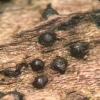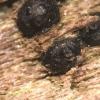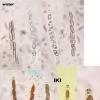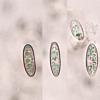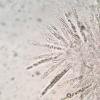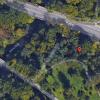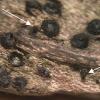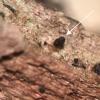
12-03-2018 16:13
Found in burned forest with Pinus halepensisDimens

10-03-2018 10:52
Found 09-03-18, in a burned forest of Pinus halepe

16-03-2018 16:10
 Christopher Engelhardt
Christopher Engelhardt
On Rubus, partly immersed in old twig. Ascospores

16-03-2018 01:07
 Viktorie Halasu
Viktorie Halasu
Hello forum,would anyone have this article please?

15-03-2018 19:10
Bonjour, Je recherche la publication suivante :

14-03-2018 19:06
Jan-Arne MentkenHello everyone,in recent days I found this anamorp

14-03-2018 19:17
 Blasco Rafael
Blasco Rafael
Hola necesito de su ayuda para llegar a conocer es
Black partially immersed stout-necked pyrenomycetes
Ethan Crenson,
06-03-2018 03:42
Asci 89-104 by 10-11µm IKI+.
Spores ellipsoid, guttulate 15-16 by 5-5.5µm
Any ideas? Thanks!
Eduard Osieck,
06-03-2018 12:04
Re : Black partially immersed stout-necked pyrenomycetes
This reminds me of the genus Torrentispora, which has been treated recently in a paper by Réblová et al.: https://www.sciencedirect.com/science/article/pii/S0166061617300507 .
Thanks to this publication I could identify some earlier collections of Torrentispora.
Eduard
Thanks to this publication I could identify some earlier collections of Torrentispora.
Eduard
Jacques Fournier,
06-03-2018 14:40

Re : Black partially immersed stout-necked pyrenomycetes
I agree with Eduard, Torrentispora is a good guess and microscopy fits well T. fibrosa.
Which is misleading on your macrophotos is that the long necks of this species are broken.
Did you find it next to a brook, suggesting an aquatic habitat before being washed out of the water? If yes it would be a further element supporting Eduard's identification.
Best,
Jacques
Which is misleading on your macrophotos is that the long necks of this species are broken.
Did you find it next to a brook, suggesting an aquatic habitat before being washed out of the water? If yes it would be a further element supporting Eduard's identification.
Best,
Jacques
Ethan Crenson,
06-03-2018 16:38
Re : Black partially immersed stout-necked pyrenomycetes
Eduard and Jacques, thank you for your help. I believe you are right that Torrentispora fits and that T. fibrosa is a strong possibility. Examining the collection again I found a few examples of fruiting bodies in which the necks had not broken. These were mostly present in fruiting bodies which were more fully immersed in the substrate.
As for the proximity to water, the collection was made near the Bronx River, however it was not in the floodplain when I found it. I suppose it is possible that the wood was moved. The collection was made at the New York Botanical Garden, where there is of course a lot of management.
I have a question about the apical annulus. Does it appear non-amyloid in my photos? Please excuse my lack of experience. I see that the apical annulus is very distinct, even without iodine. but the Lugol's does seem to change the color somewhat--perhaps a bit more green? How would you characterize what you see in my third photo in the bottom row?
Again many thanks for the comments and for directing me to the Réblová paper.
Ethan
As for the proximity to water, the collection was made near the Bronx River, however it was not in the floodplain when I found it. I suppose it is possible that the wood was moved. The collection was made at the New York Botanical Garden, where there is of course a lot of management.
I have a question about the apical annulus. Does it appear non-amyloid in my photos? Please excuse my lack of experience. I see that the apical annulus is very distinct, even without iodine. but the Lugol's does seem to change the color somewhat--perhaps a bit more green? How would you characterize what you see in my third photo in the bottom row?
Again many thanks for the comments and for directing me to the Réblová paper.
Ethan
Jacques Fournier,
06-03-2018 16:59

Re : Black partially immersed stout-necked pyrenomycetes
Hi Ethan,
in my experience such apparent greenish reactions with iodine may be in relation with the illumination of your microscope, the yellow light of halogen bulbs being the worse. Achromatic objectives often deviate refractive structures from hyaline to greenish in some mounting media. Finally the white balance setting of your camera may be involved too.
All this makes interpretation of images of microscopic slides sometimes tricky.
Jacques
in my experience such apparent greenish reactions with iodine may be in relation with the illumination of your microscope, the yellow light of halogen bulbs being the worse. Achromatic objectives often deviate refractive structures from hyaline to greenish in some mounting media. Finally the white balance setting of your camera may be involved too.
All this makes interpretation of images of microscopic slides sometimes tricky.
Jacques
Martina Reblova,
07-03-2018 19:53
Re : Black partially immersed stout-necked pyrenomycetes
Hello,
On the photographs with ascospores, some always seem a bit darker than others (positioned usually on the left or left-down side of the photos - in water). Is it possible that they turn pale brown as they mature? If ascospores become pale brown, your species reminds me of Calyptosphaeria tropica, originally described as Lentomitella tropica (Huhndorf SM, Greif M, Miller AN, 2008. Two new genera in the Magnaporthaceae, a new addition to Ceratosphaeria and two new species of Lentomitella. Mycologia 100: 940–955). Also, the shape of asci with a short, obtuse stipe better fits this genus than Torrentispora, whose ascospores remain hyaline prior to discharge and ascus stipe is longer and slender.
The size of asci and ascospores you gave match perfectly C. tropica, in protologue asci 90–100 x 9–11 um, ascospores 14.5–16 x 5–6 um. The neck, however, was described with several sulcations, but your picture shows glabrous neck. The only species with glabrous neck we saw was C. collapsa, but it has smaller ascospores 10.5–12(–12.5) × 4.5–5 um.
Martina
On the photographs with ascospores, some always seem a bit darker than others (positioned usually on the left or left-down side of the photos - in water). Is it possible that they turn pale brown as they mature? If ascospores become pale brown, your species reminds me of Calyptosphaeria tropica, originally described as Lentomitella tropica (Huhndorf SM, Greif M, Miller AN, 2008. Two new genera in the Magnaporthaceae, a new addition to Ceratosphaeria and two new species of Lentomitella. Mycologia 100: 940–955). Also, the shape of asci with a short, obtuse stipe better fits this genus than Torrentispora, whose ascospores remain hyaline prior to discharge and ascus stipe is longer and slender.
The size of asci and ascospores you gave match perfectly C. tropica, in protologue asci 90–100 x 9–11 um, ascospores 14.5–16 x 5–6 um. The neck, however, was described with several sulcations, but your picture shows glabrous neck. The only species with glabrous neck we saw was C. collapsa, but it has smaller ascospores 10.5–12(–12.5) × 4.5–5 um.
Martina

